S E C O N D E D I T I O N
MECHANICAL TOLERANCE
STACKUP AND ANALYSIS
�
MECHANICAL ENGINEERING
A Series of Textbooks and Reference Books
Founding Editor
L. L. Faulkner
Columbus Division, Battelle Memorial Institute
and Department of Mechanical Engineering
The Ohio State University
Columbus, Ohio
1. Spring Designer’s Handbook, Harold Carlson
2. Computer-Aided Graphics and Design, Daniel L. Ryan
3. Lubrication Fundamentals, J. George Wills
4. Solar Engineering for Domestic Buildings, William A. Himmelman
5. Applied Engineering Mechanics: Statics and Dynamics, G. Boothroyd
and C. Poli
6. Centrifugal Pump Clinic, Igor J. Karassik
7. Computer-Aided Kinetics for Machine Design, Daniel L. Ryan
8. Plastics Products Design Handbook, Part A: Materials and
Components; Part B: Processes and Design for Processes, edited by
Edward Miller
9. Turbomachinery: Basic Theory and Applications, Earl Logan, Jr.
10. Vibrations of Shells and Plates, Werner Soedel
11. Flat and Corrugated Diaphragm Design Handbook, Mario Di Giovanni
12. Practical Stress Analysis in Engineering Design, Alexander Blake
13. An Introduction to the Design and Behavior of Bolted Joints,
John H. Bickford
14. Optimal Engineering Design: Principles and Applications,
James N. Siddall
15. Spring Manufacturing Handbook, Harold Carlson
16.
Industrial Noise Control: Fundamentals and Applications, edited by
Lewis H. Bell
17. Gears and Their Vibration: A Basic Approach to Understanding Gear
Noise, J. Derek Smith
18. Chains for Power Transmission and Material Handling: Design
and Applications Handbook, American Chain Association
19. Corrosion and Corrosion Protection Handbook, edited by
Philip A. Schweitzer
20. Gear Drive Systems: Design and Application, Peter Lynwander
21. Controlling In-Plant Airborne Contaminants: Systems Design
and Calculations, John D. Constance
22. CAD/CAM Systems Planning and Implementation, Charles S. Knox
23. Probabilistic Engineering Design: Principles and Applications,
James N. Siddall
�
24. Traction Drives: Selection and Application, Frederick W. Heilich III
and Eugene E. Shube
25. Finite Element Methods: An Introduction, Ronald L. Huston
and Chris E. Passerello
26. Mechanical Fastening of Plastics: An Engineering Handbook,
Brayton Lincoln, Kenneth J. Gomes, and James F. Braden
27. Lubrication in Practice: Second Edition, edited by W. S. Robertson
28. Principles of Automated Drafting, Daniel L. Ryan
29. Practical Seal Design, edited by Leonard J. Martini
30. Engineering Documentation for CAD/CAM Applications,
Charles S. Knox
31. Design Dimensioning with Computer Graphics Applications,
Jerome C. Lange
32. Mechanism Analysis: Simplified Graphical and Analytical Techniques,
Lyndon O. Barton
33. CAD/CAM Systems: Justification, Implementation, Productivity
Measurement, Edward J. Preston, George W. Crawford,
and Mark E. Coticchia
34. Steam Plant Calculations Manual, V. Ganapathy
35. Design Assurance for Engineers and Managers, John A. Burgess
36. Heat Transfer Fluids and Systems for Process and Energy
Applications, Jasbir Singh
37. Potential Flows: Computer Graphic Solutions, Robert H. Kirchhoff
38. Computer-Aided Graphics and Design: Second Edition, Daniel L. Ryan
39. Electronically Controlled Proportional Valves: Selection and
Application, Michael J. Tonyan, edited by Tobi Goldoftas
40. Pressure Gauge Handbook, AMETEK, U.S. Gauge Division, edited by
Philip W. Harland
41. Fabric Filtration for Combustion Sources: Fundamentals and Basic
Technology, R. P. Donovan
42. Design of Mechanical Joints, Alexander Blake
43. CAD/CAM Dictionary, Edward J. Preston, George W. Crawford,
and Mark E. Coticchia
44. Machinery Adhesives for Locking, Retaining, and Sealing,
Girard S. Haviland
45. Couplings and Joints: Design, Selection, and Application,
Jon R. Mancuso
46. Shaft Alignment Handbook, John Piotrowski
47. BASIC Programs for Steam Plant Engineers: Boilers, Combustion,
Fluid Flow, and Heat Transfer, V. Ganapathy
48. Solving Mechanical Design Problems with Computer Graphics,
Jerome C. Lange
49. Plastics Gearing: Selection and Application, Clifford E. Adams
50. Clutches and Brakes: Design and Selection, William C. Orthwein
51. Transducers in Mechanical and Electronic Design, Harry L. Trietley
52. Metallurgical Applications of Shock-Wave and High-Strain-Rate
Phenomena, edited by Lawrence E. Murr, Karl P. Staudhammer,
and Marc A. Meyers
53. Magnesium Products Design, Robert S. Busk
�
54. How to Integrate CAD/CAM Systems: Management and Technology,
William D. Engelke
55. Cam Design and Manufacture: Second Edition; with cam design
software for the IBM PC and compatibles, disk included,
Preben W. Jensen
56. Solid-State AC Motor Controls: Selection and Application,
Sylvester Campbell
57. Fundamentals of Robotics, David D. Ardayfio
58. Belt Selection and Application for Engineers, edited by
Wallace D. Erickson
59. Developing Three-Dimensional CAD Software with the IBM PC,
C. Stan Wei
60. Organizing Data for CIM Applications, Charles S. Knox, with
contributions by Thomas C. Boos, Ross S. Culverhouse,
and Paul F. Muchnicki
61. Computer-Aided Simulation in Railway Dynamics, by Rao V. Dukkipati
and Joseph R. Amyot
62. Fiber-Reinforced Composites: Materials, Manufacturing, and Design,
P. K. Mallick
63. Photoelectric Sensors and Controls: Selection and Application,
Scott M. Juds
64. Finite Element Analysis with Personal Computers,
Edward R. Champion, Jr. and J. Michael Ensminger
65. Ultrasonics: Fundamentals, Technology, Applications: Second Edition,
Revised and Expanded, Dale Ensminger
66. Applied Finite Element Modeling: Practical Problem Solving for
Engineers, Jeffrey M. Steele
67. Measurement and Instrumentation in Engineering: Principles and Basic
Laboratory Experiments, Francis S. Tse and Ivan E. Morse
68. Centrifugal Pump Clinic: Second Edition, Revised and Expanded,
Igor J. Karassik
69. Practical Stress Analysis in Engineering Design: Second Edition,
Revised and Expanded, Alexander Blake
70. An Introduction to the Design and Behavior of Bolted Joints:
Second Edition, Revised and Expanded, John H. Bickford
71. High Vacuum Technology: A Practical Guide, Marsbed H. Hablanian
72. Pressure Sensors: Selection and Application, Duane Tandeske
73. Zinc Handbook: Properties, Processing, and Use in Design,
Frank Porter
74. Thermal Fatigue of Metals, Andrzej Weronski and Tadeusz Hejwowski
75. Classical and Modern Mechanisms for Engineers and Inventors,
Preben W. Jensen
76. Handbook of Electronic Package Design, edited by Michael Pecht
77. Shock-Wave and High-Strain-Rate Phenomena in Materials, edited by
78.
Marc A. Meyers, Lawrence E. Murr, and Karl P. Staudhammer
Industrial Refrigeration: Principles, Design and Applications,
P. C. Koelet
79. Applied Combustion, Eugene L. Keating
80. Engine Oils and Automotive Lubrication, edited by Wilfried J. Bartz
�
81. Mechanism Analysis: Simplified and Graphical Techniques,
Second Edition, Revised and Expanded, Lyndon O. Barton
82. Fundamental Fluid Mechanics for the Practicing Engineer,
James W. Murdock
83. Fiber-Reinforced Composites: Materials, Manufacturing, and Design,
Second Edition, Revised and Expanded, P. K. Mallick
84. Numerical Methods for Engineering Applications,
Edward R. Champion, Jr.
85. Turbomachinery: Basic Theory and Applications, Second Edition,
Revised and Expanded, Earl Logan, Jr.
86. Vibrations of Shells and Plates: Second Edition, Revised and
Expanded, Werner Soedel
87. Steam Plant Calculations Manual: Second Edition, Revised and
88.
Expanded, V. Ganapathy
Industrial Noise Control: Fundamentals and Applications,
Second Edition, Revised and Expanded, Lewis H. Bell
and Douglas H. Bell
89. Finite Elements: Their Design and Performance, Richard H. MacNeal
90. Mechanical Properties of Polymers and Composites: Second Edition,
Revised and Expanded, Lawrence E. Nielsen and Robert F. Landel
91. Mechanical Wear Prediction and Prevention, Raymond G. Bayer
92. Mechanical Power Transmission Components, edited by
David W. South and Jon R. Mancuso
93. Handbook of Turbomachinery, edited by Earl Logan, Jr.
94. Engineering Documentation Control Practices and Procedures,
Ray E. Monahan
95. Refractory Linings Thermomechanical Design and Applications,
Charles A. Schacht
96. Geometric Dimensioning and Tolerancing: Applications and
Techniques for Use in Design, Manufacturing, and Inspection,
James D. Meadows
97. An Introduction to the Design and Behavior of Bolted Joints:
Third Edition, Revised and Expanded, John H. Bickford
98. Shaft Alignment Handbook: Second Edition, Revised and Expanded,
John Piotrowski
99. Computer-Aided Design of Polymer-Matrix Composite Structures,
edited by Suong Van Hoa
100. Friction Science and Technology, Peter J. Blau
101. Introduction to Plastics and Composites: Mechanical Properties
and Engineering Applications, Edward Miller
102. Practical Fracture Mechanics in Design, Alexander Blake
103. Pump Characteristics and Applications, Michael W. Volk
104. Optical Principles and Technology for Engineers, James E. Stewart
105. Optimizing the Shape of Mechanical Elements and Structures,
A. A. Seireg and Jorge Rodriguez
106. Kinematics and Dynamics of Machinery, Vladimír Stejskal
and Michael Valásek
107. Shaft Seals for Dynamic Applications, Les Horve
108. Reliability-Based Mechanical Design, edited by Thomas A. Cruse
109. Mechanical Fastening, Joining, and Assembly, James A. Speck
�
110. Turbomachinery Fluid Dynamics and Heat Transfer, edited by
Chunill Hah
111. High-Vacuum Technology: A Practical Guide, Second Edition,
Revised and Expanded, Marsbed H. Hablanian
112. Geometric Dimensioning and Tolerancing: Workbook and Answerbook,
James D. Meadows
113. Handbook of Materials Selection for Engineering Applications,
edited by G. T. Murray
114. Handbook of Thermoplastic Piping System Design, Thomas Sixsmith
and Reinhard Hanselka
115. Practical Guide to Finite Elements: A Solid Mechanics Approach,
Steven M. Lepi
116. Applied Computational Fluid Dynamics, edited by Vijay K. Garg
117. Fluid Sealing Technology, Heinz K. Muller and Bernard S. Nau
118. Friction and Lubrication in Mechanical Design, A. A. Seireg
119. Influence Functions and Matrices, Yuri A. Melnikov
120. Mechanical Analysis of Electronic Packaging Systems,
Stephen A. McKeown
121. Couplings and Joints: Design, Selection, and Application,
Second Edition, Revised and Expanded, Jon R. Mancuso
122. Thermodynamics: Processes and Applications, Earl Logan, Jr.
123. Gear Noise and Vibration, J. Derek Smith
124. Practical Fluid Mechanics for Engineering Applications,
John J. Bloomer
125. Handbook of Hydraulic Fluid Technology, edited by George E. Totten
126. Heat Exchanger Design Handbook, T. Kuppan
127. Designing for Product Sound Quality, Richard H. Lyon
128. Probability Applications in Mechanical Design, Franklin E. Fisher
and Joy R. Fisher
129. Nickel Alloys, edited by Ulrich Heubner
130. Rotating Machinery Vibration: Problem Analysis and Troubleshooting,
Maurice L. Adams, Jr.
131. Formulas for Dynamic Analysis, Ronald L. Huston and C. Q. Liu
132. Handbook of Machinery Dynamics, Lynn L. Faulkner and Earl Logan, Jr.
133. Rapid Prototyping Technology: Selection and Application,
Kenneth G. Cooper
134. Reciprocating Machinery Dynamics: Design and Analysis,
Abdulla S. Rangwala
135. Maintenance Excellence: Optimizing Equipment Life-Cycle Decisions,
edited by John D. Campbell and Andrew K. S. Jardine
136. Practical Guide to Industrial Boiler Systems, Ralph L. Vandagriff
137. Lubrication Fundamentals: Second Edition, Revised and Expanded,
D. M. Pirro and A. A. Wessol
138. Mechanical Life Cycle Handbook: Good Environmental Design
and Manufacturing, edited by Mahendra S. Hundal
139. Micromachining of Engineering Materials, edited by Joseph McGeough
140. Control Strategies for Dynamic Systems: Design and Implementation,
John H. Lumkes, Jr.
141. Practical Guide to Pressure Vessel Manufacturing, Sunil Pullarcot
�
142. Nondestructive Evaluation: Theory, Techniques, and Applications,
edited by Peter J. Shull
143. Diesel Engine Engineering: Thermodynamics, Dynamics, Design,
and Control, Andrei Makartchouk
144. Handbook of Machine Tool Analysis, Ioan D. Marinescu,
Constantin Ispas, and Dan Boboc
145. Implementing Concurrent Engineering in Small Companies,
Susan Carlson Skalak
146. Practical Guide to the Packaging of Electronics: Thermal and
Mechanical Design and Analysis, Ali Jamnia
147. Bearing Design in Machinery: Engineering Tribology and Lubrication,
Avraham Harnoy
148. Mechanical Reliability Improvement: Probability and Statistics
for Experimental Testing, R. E. Little
149. Industrial Boilers and Heat Recovery Steam Generators: Design,
Applications, and Calculations, V. Ganapathy
150. The CAD Guidebook: A Basic Manual for Understanding and
Improving Computer-Aided Design, Stephen J. Schoonmaker
151. Industrial Noise Control and Acoustics, Randall F. Barron
152. Mechanical Properties of Engineered Materials, Wolé Soboyejo
153. Reliability Verification, Testing, and Analysis in Engineering Design,
Gary S. Wasserman
154. Fundamental Mechanics of Fluids: Third Edition, I. G. Currie
155. Intermediate Heat Transfer, Kau-Fui Vincent Wong
156. HVAC Water Chillers and Cooling Towers: Fundamentals, Application,
and Operation, Herbert W. Stanford III
157. Gear Noise and Vibration: Second Edition, Revised and Expanded,
J. Derek Smith
158. Handbook of Turbomachinery: Second Edition, Revised and
Expanded, edited by Earl Logan, Jr. and Ramendra Roy
159. Piping and Pipeline Engineering: Design, Construction, Maintenance,
Integrity, and Repair, George A. Antaki
160. Turbomachinery: Design and Theory, Rama S. R. Gorla
and Aijaz Ahmed Khan
161. Target Costing: Market-Driven Product Design, M. Bradford Clifton,
Henry M. B. Bird, Robert E. Albano, and Wesley P. Townsend
162. Fluidized Bed Combustion, Simeon N. Oka
163. Theory of Dimensioning: An Introduction to Parameterizing Geometric
Models, Vijay Srinivasan
164. Handbook of Mechanical Alloy Design, edited by George E. Totten,
Lin Xie, and Kiyoshi Funatani
165. Structural Analysis of Polymeric Composite Materials, Mark E. Tuttle
166. Modeling and Simulation for Material Selection and Mechanical
Design, edited by George E. Totten, Lin Xie, and Kiyoshi Funatani
167. Handbook of Pneumatic Conveying Engineering, David Mills,
Mark G. Jones, and Vijay K. Agarwal
168. Clutches and Brakes: Design and Selection, Second Edition,
William C. Orthwein
169. Fundamentals of Fluid Film Lubrication: Second Edition,
Bernard J. Hamrock, Steven R. Schmid, and Bo O. Jacobson
�
170. Handbook of Lead-Free Solder Technology for Microelectronic
Assemblies, edited by Karl J. Puttlitz and Kathleen A. Stalter
171. Vehicle Stability, Dean Karnopp
172. Mechanical Wear Fundamentals and Testing: Second Edition,
Revised and Expanded, Raymond G. Bayer
173. Liquid Pipeline Hydraulics, E. Shashi Menon
174. Solid Fuels Combustion and Gasification, Marcio L. de Souza-Santos
175. Mechanical Tolerance Stackup and Analysis, Bryan R. Fischer
176. Engineering Design for Wear, Raymond G. Bayer
177. Vibrations of Shells and Plates: Third Edition, Revised and Expanded,
Werner Soedel
178. Refractories Handbook, edited by Charles A. Schacht
179. Practical Engineering Failure Analysis, Hani M. Tawancy,
Anwar Ul-Hamid, and Nureddin M. Abbas
180. Mechanical Alloying and Milling, C. Suryanarayana
181. Mechanical Vibration: Analysis, Uncertainties, and Control,
Second Edition, Revised and Expanded, Haym Benaroya
182. Design of Automatic Machinery, Stephen J. Derby
183. Practical Fracture Mechanics in Design: Second Edition,
Revised and Expanded, Arun Shukla
184. Practical Guide to Designed Experiments, Paul D. Funkenbusch
185. Gigacycle Fatigue in Mechanical Practive, Claude Bathias
and Paul C. Paris
186. Selection of Engineering Materials and Adhesives, Lawrence W. Fisher
187. Boundary Methods: Elements, Contours, and Nodes, Subrata
Mukherjee and Yu Xie Mukherjee
188. Rotordynamics, Agnieszka (Agnes) Muszn´yska
189. Pump Characteristics and Applications: Second Edition,
Michael W. Volk
190. Reliability Engineering: Probability Models and Maintenance Methods,
Joel A. Nachlas
191. Industrial Heating: Principles, Techniques, Materials, Applications,
and Design, Yeshvant V. Deshmukh
192. Micro Electro Mechanical System Design, James J. Allen
193. Probability Models in Engineering and Science, Haym Benaroya
and Seon Han
194. Damage Mechanics, George Z. Voyiadjis and Peter I. Kattan
195. Standard Handbook of Chains: Chains for Power Transmission
and Material Handling, Second Edition, American Chain Association
and John L. Wright, Technical Consultant
196. Standards for Engineering Design and Manufacturing,
Wasim Ahmed Khan and Abdul Raouf S.I.
197. Maintenance, Replacement, and Reliability: Theory and Applications,
Andrew K. S. Jardine and Albert H. C. Tsang
198. Finite Element Method: Applications in Solids, Structures, and Heat
Transfer, Michael R. Gosz
199. Microengineering, MEMS, and Interfacing: A Practical Guide,
Danny Banks
�
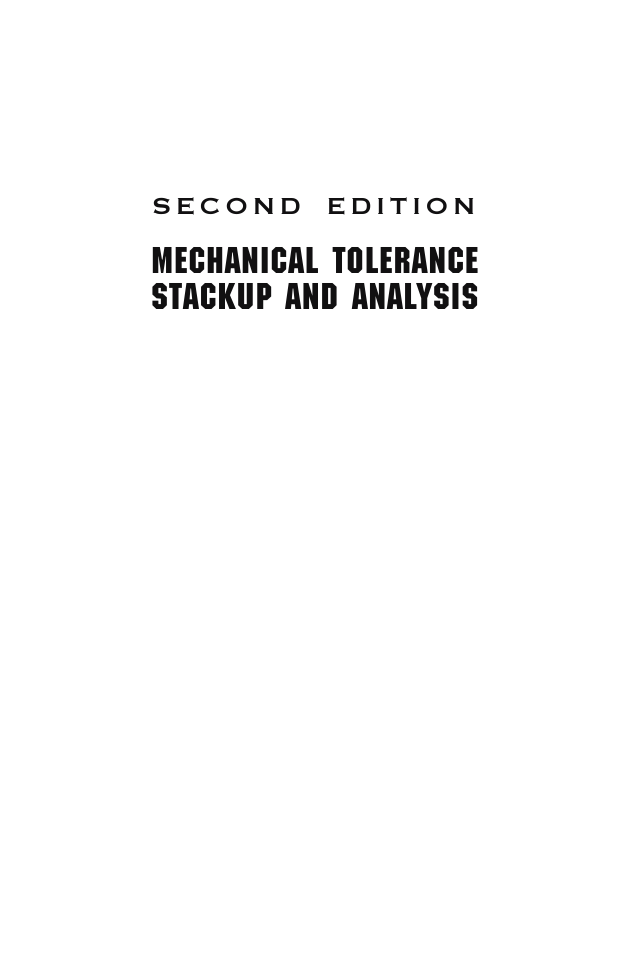
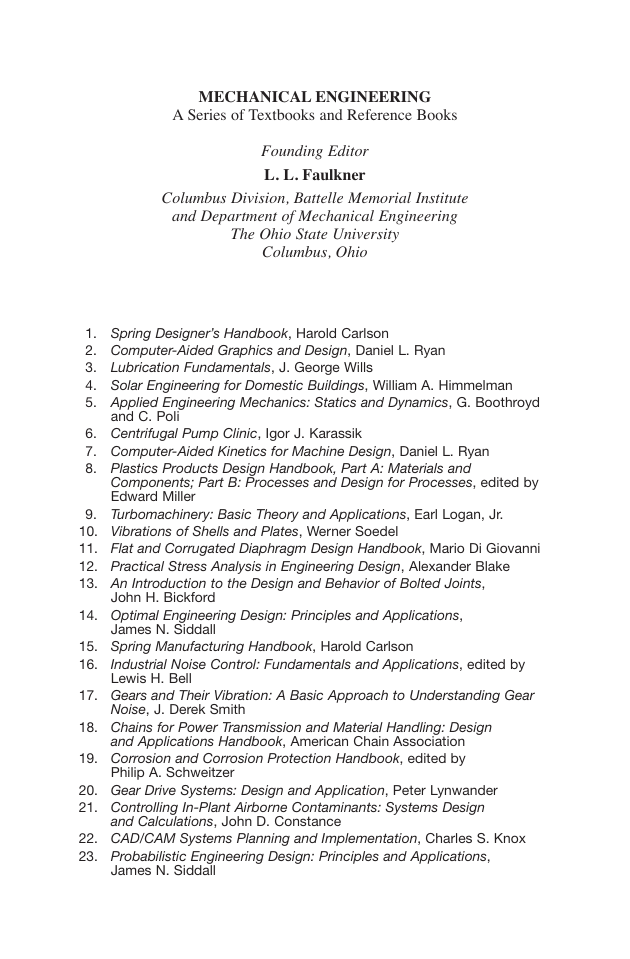
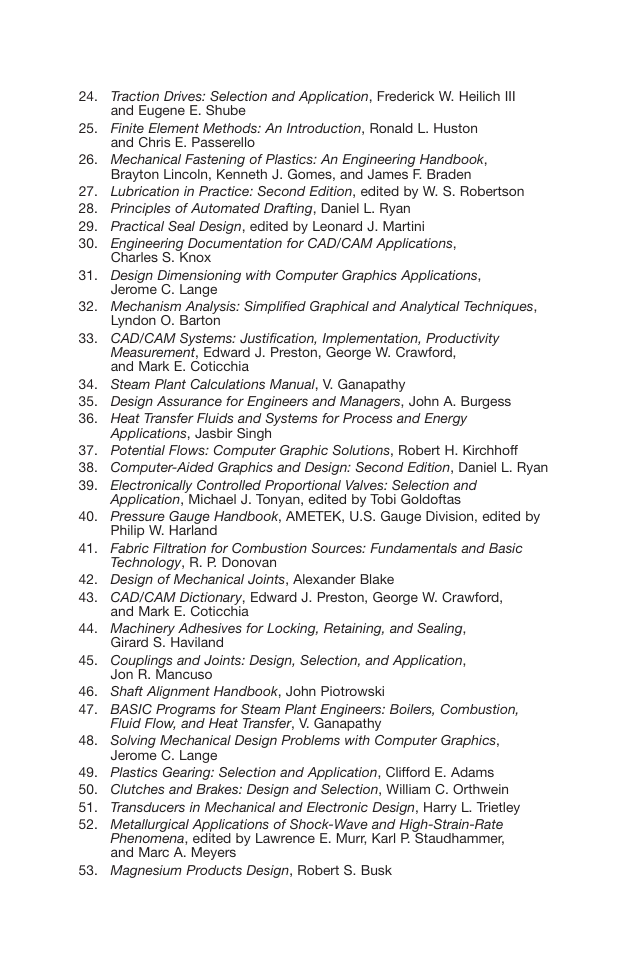
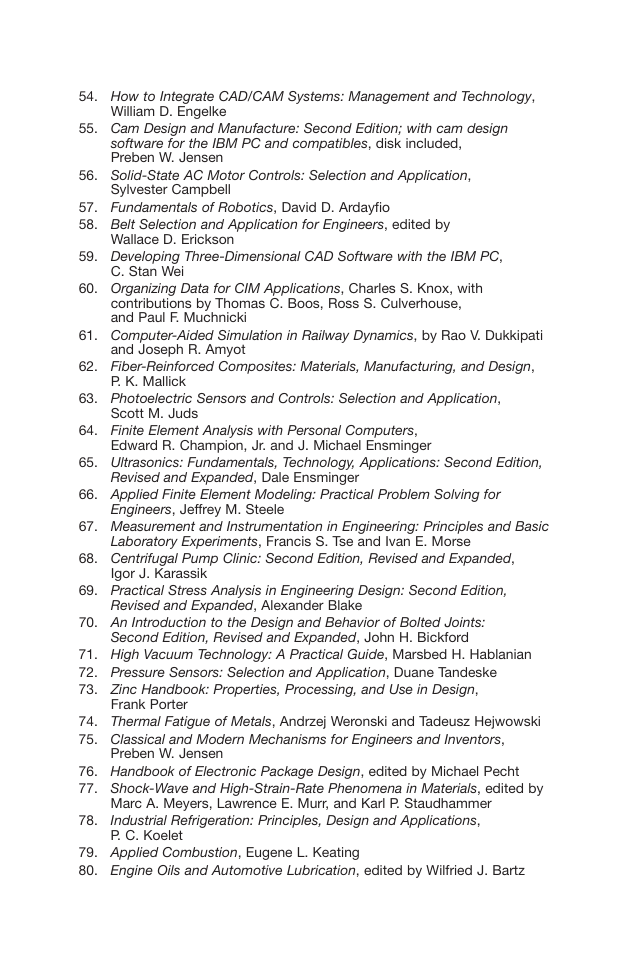
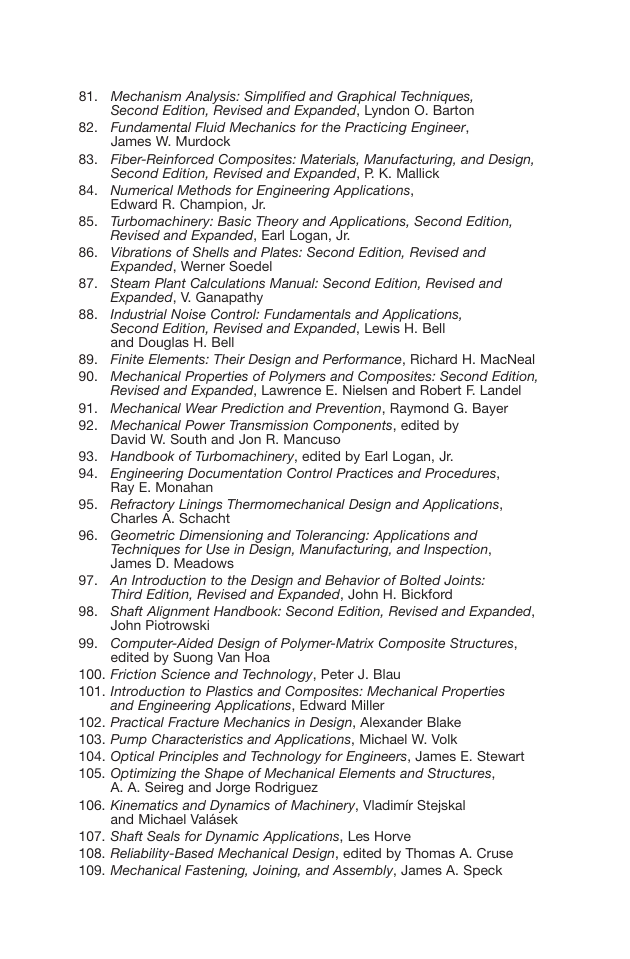
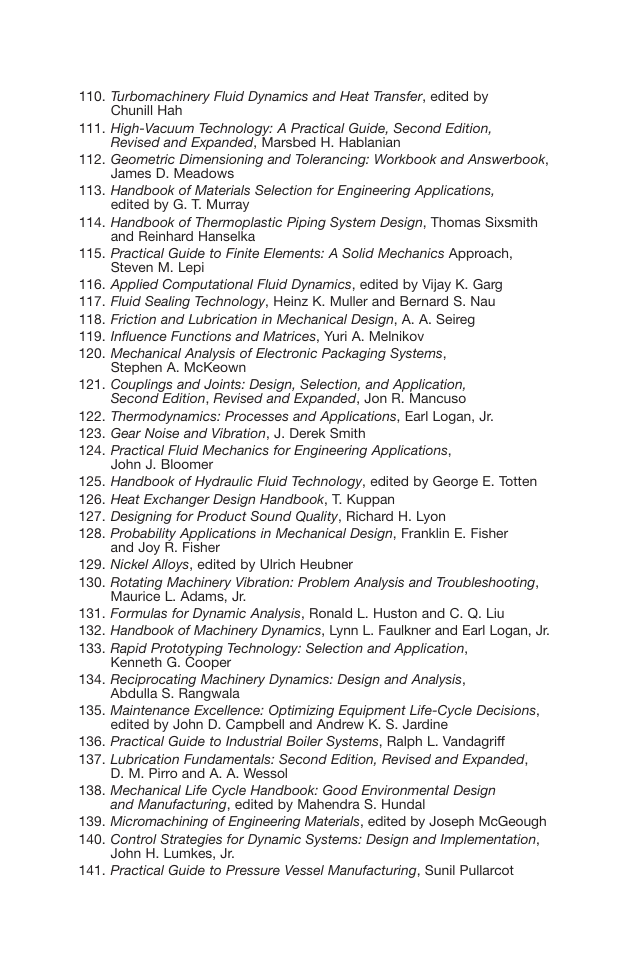

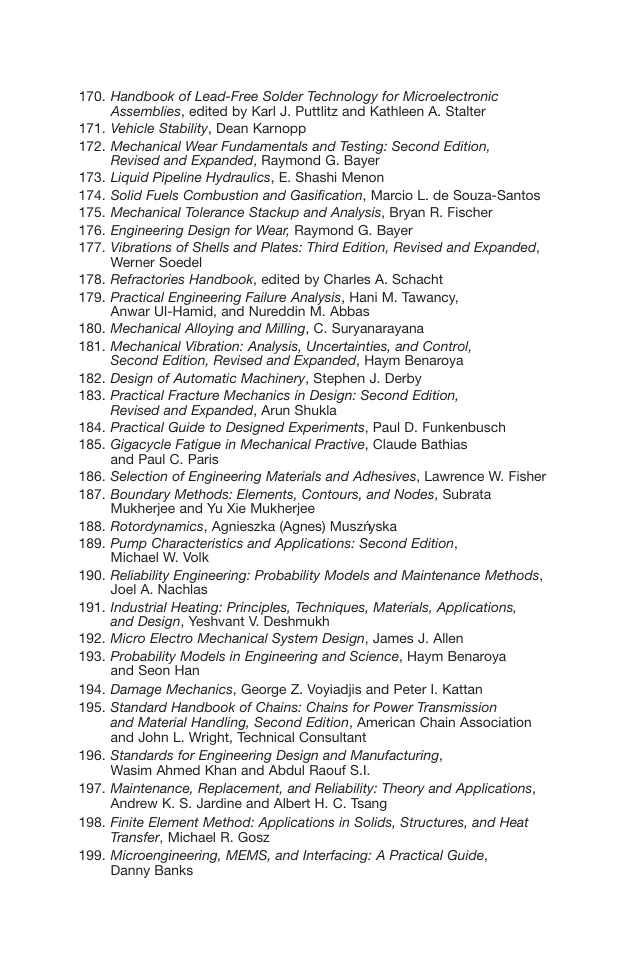








 2023年江西萍乡中考道德与法治真题及答案.doc
2023年江西萍乡中考道德与法治真题及答案.doc 2012年重庆南川中考生物真题及答案.doc
2012年重庆南川中考生物真题及答案.doc 2013年江西师范大学地理学综合及文艺理论基础考研真题.doc
2013年江西师范大学地理学综合及文艺理论基础考研真题.doc 2020年四川甘孜小升初语文真题及答案I卷.doc
2020年四川甘孜小升初语文真题及答案I卷.doc 2020年注册岩土工程师专业基础考试真题及答案.doc
2020年注册岩土工程师专业基础考试真题及答案.doc 2023-2024学年福建省厦门市九年级上学期数学月考试题及答案.doc
2023-2024学年福建省厦门市九年级上学期数学月考试题及答案.doc 2021-2022学年辽宁省沈阳市大东区九年级上学期语文期末试题及答案.doc
2021-2022学年辽宁省沈阳市大东区九年级上学期语文期末试题及答案.doc 2022-2023学年北京东城区初三第一学期物理期末试卷及答案.doc
2022-2023学年北京东城区初三第一学期物理期末试卷及答案.doc 2018上半年江西教师资格初中地理学科知识与教学能力真题及答案.doc
2018上半年江西教师资格初中地理学科知识与教学能力真题及答案.doc 2012年河北国家公务员申论考试真题及答案-省级.doc
2012年河北国家公务员申论考试真题及答案-省级.doc 2020-2021学年江苏省扬州市江都区邵樊片九年级上学期数学第一次质量检测试题及答案.doc
2020-2021学年江苏省扬州市江都区邵樊片九年级上学期数学第一次质量检测试题及答案.doc 2022下半年黑龙江教师资格证中学综合素质真题及答案.doc
2022下半年黑龙江教师资格证中学综合素质真题及答案.doc